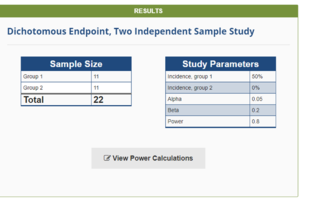In your case, you want to perform a two-sample t-test to compare two groups: one where a fraction of red blood cells is contaminated with white blood cells (before your new method), and another where you hope that this fraction is not contaminated anymore (after applying your new method). You want to determine the sample size needed to detect a significant difference between these groups with a specified level of statistical power.
[math]n = \dfrac{(Z_{\alpha/2}+Z_\beta)^2\cdot \sigma^2}{\delta^2}[/math]
where:
[imath]Z_{\alpha/2}[/imath] is the critical value for your [imath]\alpha/2 = 0.05/2[/imath]
[imath]Z_\beta[/imath] is the critical value for your desired power 80% or [imath]\beta = 0.2[/imath]
[imath]\sigma[/imath] is the estimated standard deviation of the population.
[imath]\delta [/imath] is the effect size (the difference you want to detect).
The last 2 is where you need to make some assumptions using prior data, pilot study, literature review, existing knowledge, etc... In layman's terms, your judgment call.
Things to consider:
1) It's important to choose values for [imath]\sigma[/imath] and [imath]\delta[/imath] that are both realistic and meaningful in your specific research context. If you're uncertain about the values, it's better to be conservative and overestimate the required sample size. This way, you ensure that your study is adequately powered to detect meaningful differences, and you may collect more data than is strictly necessary.
2) Remember that larger sample sizes can increase the power of your study but may also be more resource-intensive. Therefore, it's essential to balance statistical power with practical constraints.
Note that the first question isn't the same as the second one you posted because the first question attempts to detect a proportion of zero (i.e., nobody living for 70 years or longer) with high power. Whereas the second question attempts to detect a meaningful difference due to the new method. Unless I misunderstood the goal of your study, the calculation for the first question would've been different. My point here is that your research question should be clear, specific, and well-defined. It sets the stage for the entire research process and guides your methodology, including the choice of statistical tests and sample size calculations.


